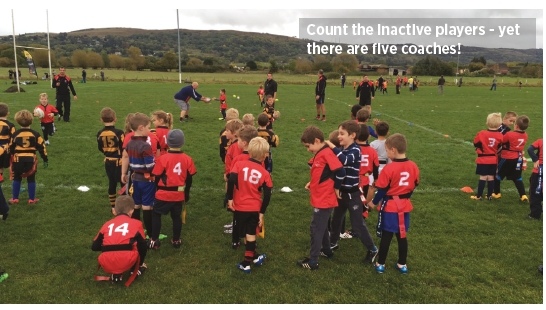Causes and cures of disruptive behaviour in your rugby coaching sessions

Avoid long lines
The unwritten “Law of Queuing” says that, with more than three players in a line, even the most well-behaved player starts to mess around.
For the more disruptive player this can lead to pushing, shoving and even bullying. It is irresistible. It is also hard to control when the coach is further up the field watching the action.
Instead, have more than one starting point, so the queues are shorter. Alternatively, get players to sit down on the side when a drill is completed before returning to the queue.
Ideally, though, the level of activity should be such that queues rarely form, but this might not always be possible.
Big groups, short chats
When talking to a big group, there is a danger of disruption due to the close proximity of players. The disruptive player will often be at the back. Sit them all down, and bring the worst offenders to the front.
Watch out for the players who wander behind you when you are talking. Any group situation must be on your terms. With big groups, anything more than a one minute chat can be an ideal breeding ground for a disruptive player.
Organisation, action and fun
A well-organised practice, which means a lot of activity for the players, will reduce the opportunity for disruption. Too many drills, too little time for games means players get bored. And the greater the action, running around, the more likely that players will become tired.
A physically tired player will be less likely to muck around – he will be recovering!
Avoid negative feedback
Instead of criticism, use the “feedback sandwich”. Combining positive feedback with corrective feedback will make a player think about the practice or drill itself, rather than feeling the focus is on his or her behaviour.
If a player can repeat back the instructions, this shows that they understand.
The worst thing you can do is use a phrase like “Well, if you had been listening and not mucking around… ”
A better approach would be to say: “Good weight on the pass, Dave. Try to improve your support play by keeping close to the first ball carrier” – this to a player who was chatting in the line, and didn’t keep up.
Excluding a player
If you have tried all the tactics to keep a player in the practice, send him away for a short space of time to “cool down”. This should never be an empty threat and be adopted only as a last resort. It should be used very sparingly.
- If a child has to repeatedly sit out, then you are in a situation which goes beyond normal practice management. In this case refer to your club’s or school’s policy.
Bring them back with a quick word from you (which should look at the positives), with a response from them to indicate they understand. Then on with the practice, a line drawn under the incident.
This article is from our Motivating Your Team manual. This manual is a practical, no-nonsense guide to getting your players to perform to their true potential.
For more rugby coaching tips and products visit Rugby Coaching Club.
Newsletter Sign Up
Coaches Testimonials

Gerald Kearney, Downtown Las Vegas Soccer Club

Paul Butler, Florida, USA

Rick Shields, Springboro, USA

Tony Green, Pierrefonds Titans, Quebec, Canada
Subscribe Today
Be a more effective, more successful rugby coach
In a recent survey 89% of subscribers said Rugby Coach Weekly makes them more confident, 91% said Rugby Coach Weekly makes them a more effective coach and 93% said Rugby Coach Weekly makes them more inspired.
Get Weekly Inspiration
All the latest techniques and approaches
Rugby Coach Weekly offers proven and easy to use rugby drills, coaching sessions, practice plans, small-sided games, warm-ups, training tips and advice.
We've been at the cutting edge of rugby coaching since we launched in 2005, creating resources for the grassroots youth coach, following best practice from around the world and insights from the professional game.













